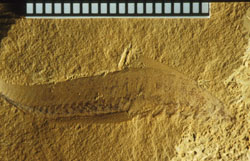Research
Research: Early Metazoan Evolution

The oldest known fossil fish, Myllokunmingia from the Lower Cambrian Chengjiang Lagerstätte of South China. Clearly visible are the anterior gills, dorsal fin and trunk myomeres. The specimen is about 2 cm in length.
My focus of research concerns the study of the constraints on evolution, and the historical processes that lead to the emergence of complexity, especially with respect to the construction of the major animal bodyplans in the Cambrian explosion. My work is central to palaeobiology, but is also of great interest to biologists and bioastronomers, as well as the wider community.
Cambrian Explosion
In the last few years we have made a series of major contributions to our understanding of the evolution of metazoan body plans, especially with respect to the lophotrochozoans and deuterostomes. The latter super-phylum is the group to which we belong, and in addition to documenting the earliest known fish we now have key data on the earliest evolution of the deuterostomes. Much of this work is based in China, but I also have continuing interests in equivalent material from North America.
Evolutionary Convergence
Arising from my interest in the Cambrian “explosion”, my book “Life's Solution: Inevitable Humans in a Lonely Universe” (Cambridge: Cambridge University Press, 2003), on the broad topic of evolutionary convergence, emphasizing the parallel evolution of sensory systems e.g. vision, olfaction, echolocation, and also intelligence, especially in the primates and cetaceans. This book has made a considerable impact, as it throws severe doubt on a number of fashionable presuppositions in evolution. More recently I have published “The Runes of Evolution: How the Universe Became Self-Aware” (Templeton Press, 2015), which extends many of the themes seen in “Life’s Solution”.
Wider aspects of evolution
In addition to my work on the Cambrian “explosion”, I am developing a wide portfolio of interests across the entire field of evolution, including the question of animal cognition (including numerosity) and extra-terrestrial life.
Publications
Han, J., Conway Morris, S., Hoyal Cuthill, J. F. & Shu, D. Sclerite-bearing annelids from the lower Cambrian of South China. Sci Rep 9, 4955 (2019).
Conway Morris, S. Three explanations for extraterrestrials: Sensible, unlikely, mad. International Journal of Astrobiology 17, 287–293 (2018).
Shu, D. et al. Multi-jawed chaetognaths from the Chengjiang Lagerstätte (Cambrian, Series 2, Stage 3) of Yunnan, China. Palaeontology 60, 763–772 (2017).
Hoyal Cuthill, J. F. & Conway Morris, S. Nutrient-dependent growth underpinned the Ediacaran transition to large body size. Nat Ecol Evol 1, 1201–1204 (2017).
Han, J., Morris, S. C., Ou, Q., Shu, D. & Huang, H. Meiofaunal deuterostomes from the basal Cambrian of Shaanxi (China). Nature 542, 228–231 (2017).
Nanglu, K., Caron, J.-B., Conway Morris, S. & Cameron, C. B. Cambrian suspension-feeding tubicolous hemichordates. BMC Biol 14, 56 (2016).
Conway Morris, S. It all adds up …. Or does it? Numbers, mathematics and purpose. Stud Hist Philos Biol Biomed Sci 58, 117–122 (2016).
Morris, S. C., Selden, P. A., Gunther, G., Jamison, P. G. & Robison, R. A. New records of Burgess Shale-type taxa from the middle Cambrian of Utah. Journal of Paleontology 89, 411–423 (2015).
Morris, S. C., Halgedahl, S. L., Selden, P. & Jarrard, R. D. Rare primitive deuterostomes from the Cambrian (Series 3) of Utah. Journal of Paleontology 89, 631–636 (2015).
Conway Morris, S., Hoyal Cuthill, J. F. & Gerber, S. Hunting Darwin’s Snark: Which maps shall we use? Interface Focus 5, (2015).
Morris, S. C. & Caron, J. B. A primitive fish from the Cambrian of North America. Nature 512, 419–422 (2014).
Morris, S. C. & Caron, J.-B. A primitive fish from the Cambrian of North America. Nature 512, 419–422 (2014).
Hoyal Cuthill, J. F. & Conway Morris, S. Fractal branching organizations of Ediacaran rangeomorph fronds reveal a lost Proterozoic body plan. Proc Natl Acad Sci U S A 111, 13122–13126 (2014).
Morris, S. C. & Peel, J. S. A NEW HELCIONELLOID MOLLUSK FROM THE MIDDLE CAMBRIAN BURGESS SHALE, CANADA. JOURNAL OF PALEONTOLOGY 87, 1067–1070 (2013).
Caron, J.-B., Morris, S. C. & Cameron, C. B. Tubicolous enteropneusts from the Cambrian period. Nature 495, 503–506 (2013).
Ou, Q. et al. Evidence for gill slits and a pharynx in Cambrian vetulicolians: implications for the early evolution of deuterostomes. BMC BIOLOGY 10, (2012).
Morris, S. C. & Caron, J.-B. Pikaia gracilens Walcott, a stem-group chordate from the Middle Cambrian of British Columbia. Biological Reviews 87, 480–512 (2012).
Morris, S. C. Molecules of choice? EMBO Reports 13, 281 (2012).
Morris, S. C. Creation and Evolutionary Convergence. The Blackwell Companion to Science and Christianity 258–269 (2012) doi:10.1002/9781118241455.ch23.
Morris, S. C. Consider the octopus. EMBO Reports 12, 182 (2011).
Morris, S. C. Complexity: The ultimate frontier? EMBO Reports 12, 481–482 (2011).
Shu, D. G., Conway Morris, S., Zhang, Z. F. & Han, J. The earliest history of the deuterostomes: The importance of the Chengjiang Fossil-Lagerstätte. Proceedings of the Royal Society B: Biological Sciences 277, 165–174 (2010).
Shu, D.-G., Morris, S. C., Zhang, Z.-F. & Han, J. The earliest history of the deuterostomes: The importance of the Chengjiang Fossil-Lagerstätte. Proceedings of the Royal Society B: Biological Sciences 277, 165–174 (2010).
Morris, S. C. & Peel, J. S. New palaeoscolecidan worms from the lower cambrian: Sirius passet, Latham Shale and Kinzers Shale. Acta Palaeontologica Polonica 55, 141–156 (2010).
Morris, S. C. & Peel, J. New palaeoscolecidan worms from the lower Cambrian : Siriuis Fossil-Lagerstatte (North Greenland), Latham Shale (California), and Kinzers Shale (Pennsylvania). Acta Palaeontologica Polonica 51, 141–156 (2010).
Morris, S. C. What is written into creation? in Creation and the God of Abraham 176–191 (2010). doi:10.1017/CBO9780511778063.013.
Morris, S. C. Predicting what extraterrestrials will be like—and preparing for the worst. Philosophical Transactions of the Royal Society A: Mathematical, Physical and Engineering Sciences (2010).
Morris, S. C. Life: The final frontier for complexity? in Complexity and the Arrow of Time 135–161 (2010). doi:10.1017/CBO9781139225700.010.
Morris, S. C. Evolution: Like any other science it is predictable. Philosophical Transactions of the Royal Society B: Biological Sciences 365, 133–145 (2010).
Morris, S. C. Evolution and the inevitability of intelligent life. in The Cambridge Companion to Science and Religion 148–172 (2010). doi:10.1017/CCOL9780521885386.008.
Morris, S. C. Darwin at the edge of the visible universe. EMBO Rep 11, 898–898 (2010).
Morris, S. C. Aliens at home? EMBO reports 11, 563–563 (2010).
Caron, J. B., Morris, S. C. & Shu, D. G. Tentaculate fossils from the Cambrian of Canada (British Columbia) and China (Yunnan) interpreted as primitive deuterostomes. PLoS Biology (2010).
Morris, S. C. Walcott, the Burgess Shale and rumours of a post-Darwinian world. Current Biology 19, R927–R931 (2009).
Morris, S. C. The predictability of evolution: glimpses into a post-Darwinian world. Naturwissenschaften 96, 1313–1337 (2009).
Morris, S. C. The Burgess shall animal Oesia is not a chaetognath: a reply to Szaniawski (2005). Acta Palaeontologica Polonica 54, 175–179 (2009).
Morris, S. C. Cherchez le Darwinism. (2009).
Dawkins, R. et al. Evolution’s final frontiers. NEW SCIENTIST 201, 41–43 (2009).
Berry, A. et al. (Re)Reading The Origin. Current Biology 19, R96–R96 (2009).
Shubin, N. & Morris, S. C. Evolution’s Russian doll. NEW SCIENTIST 197, 45–45 (2008).
Morris, S. C. & Peel, J. S. The earliest annelids: Lower Cambrian polychaetes from the Sirius Passet Lagerstätte, Peary Land, North Greenland. Acta Palaeontologica Polonica 53, 137–148 (2008).
Morris, S. C. & Peel, J. S. The earliest annelids: Lower Cambrian polychaetes from the Sirius Passet Lagerstatte, Peary Land, North Greenland. ACTA PALAEONTOLOGICA POLONICA 53, 135–146 (2008).
Morris, S. C. A redescription of a rare chordate, metaspriggina walcotti Simonetta and Insom, from the Burgess shale (middle Cambrian), British Columbia, Canada. Journal of Paleontology 82, 424–430 (2008).
Morris, S. C. & Caron, J. B. Halwaxiids and the early evolution of the Lophotrochozoans. Science 315, 1255–1258 (2007).
Morris, S. C. Tuning into the frequencies of life: a roar of static or a precise signal? in Fitness of the cosmos for life (eds. Barrow, J. D., Morris, S. C., Freeland, S. J. & Harper, J. C. L.) 501–501 (Cambridge University Press, 2007).
Shu, D. G. et al. Lower Cambrian vendobionts from China and early diploblast evolution. Science 312, 731–734 (2006).
Shu, D. G. et al. Lower Cambrian vendobionts from China and early diploblast evolution. Science 312, 731–734 (2006).
Shu, D. G. & Morris, S. C. New diploblasts from Chengiiang fossil lagerstatte. Earth Science Frontiers 13, 227–233 (2006).
Morris, S. C. & Grazhdankin, D. A post-script to the enigmatic Protonympha (Devonian; New York): is it an arm of the echinoderms? Palaeontology 49, 1335–1338 (2006).
Morris, S. C. The Road to Hell? Book review of: ‘The creation: An appeal to save life on earth’ by E. O. Wilson. Nature 443, 273–273 (2006).

